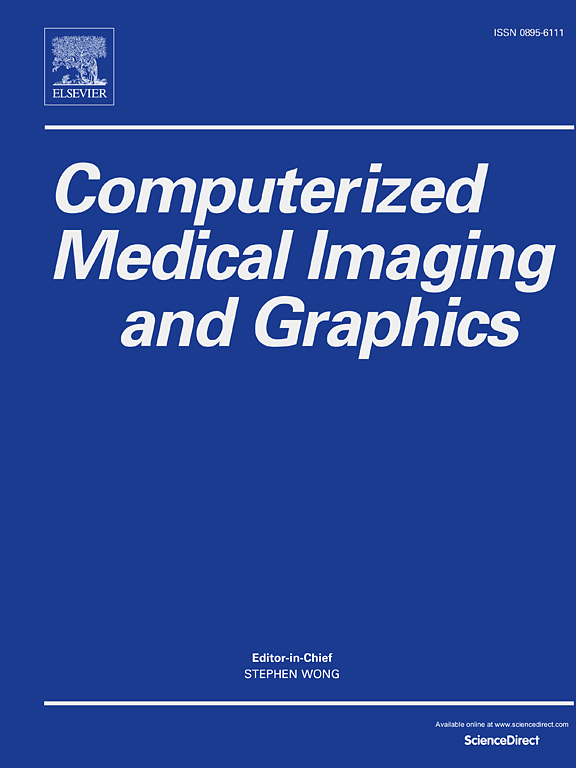基于深度平衡展开学习的光学分子成像噪声估计与去除。
IF 5.4
2区 医学
Q1 ENGINEERING, BIOMEDICAL
Computerized Medical Imaging and Graphics
Pub Date : 2025-01-08
DOI:10.1016/j.compmedimag.2025.102492
引用次数: 0
摘要
在临床光学分子成像中,需要实时高帧率和低激发剂量来确保患者安全,这本质上增加了对检测噪声的敏感性。面对严重噪声导致图像退化的挑战,图像去噪是缓解采集成本和图像质量之间权衡的关键。然而,目前流行的深度学习方法表现出不可控和次优性能,可解释性有限,主要是由于忽略了底层物理模型和频率信息。在这项工作中,我们介绍了一个端到端模型驱动的深度平衡展开曼巴(DEQ-UMamba),它集成了近端梯度下降技术和学习的空间频率特征,将复杂的噪声结构解耦到统计分布中,从而能够有效地估计和抑制荧光图像中的噪声。此外,为了解决展开网络的计算限制,DEQ-UMamba通过直接微分收敛解的平衡点来训练隐式映射,从而确保稳定性并避免非收敛行为。在迭代优化过程中,每个网络模块对应一个操作,具有清晰的结构可解释性和较强的性能。在临床和体内数据集上进行的综合实验表明,DEQ-UMamba优于目前最先进的替代方案,同时使用更少的参数,促进了成本效益和高质量临床分子成像的进步。本文章由计算机程序翻译,如有差异,请以英文原文为准。

Deep Equilibrium Unfolding Learning for Noise Estimation and Removal in Optical Molecular Imaging
In clinical optical molecular imaging, the need for real-time high frame rates and low excitation doses to ensure patient safety inherently increases susceptibility to detection noise. Faced with the challenge of image degradation caused by severe noise, image denoising is essential for mitigating the trade-off between acquisition cost and image quality. However, prevailing deep learning methods exhibit uncontrollable and suboptimal performance with limited interpretability, primarily due to neglecting underlying physical model and frequency information. In this work, we introduce an end-to-end model-driven Deep Equilibrium Unfolding Mamba (DEQ-UMamba) that integrates proximal gradient descent technique and learnt spatial-frequency characteristics to decouple complex noise structures into statistical distributions, enabling effective noise estimation and suppression in fluorescent images. Moreover, to address the computational limitations of unfolding networks, DEQ-UMamba trains an implicit mapping by directly differentiating the equilibrium point of the convergent solution, thereby ensuring stability and avoiding non-convergent behavior. With each network module aligned to a corresponding operation in the iterative optimization process, the proposed method achieves clear structural interpretability and strong performance. Comprehensive experiments conducted on both clinical and in vivo datasets demonstrate that DEQ-UMamba outperforms current state-of-the-art alternatives while utilizing fewer parameters, facilitating the advancement of cost-effective and high-quality clinical molecular imaging.
求助全文
通过发布文献求助,成功后即可免费获取论文全文。
去求助
来源期刊
CiteScore
10.70
自引率
3.50%
发文量
71
审稿时长
26 days
期刊介绍:
The purpose of the journal Computerized Medical Imaging and Graphics is to act as a source for the exchange of research results concerning algorithmic advances, development, and application of digital imaging in disease detection, diagnosis, intervention, prevention, precision medicine, and population health. Included in the journal will be articles on novel computerized imaging or visualization techniques, including artificial intelligence and machine learning, augmented reality for surgical planning and guidance, big biomedical data visualization, computer-aided diagnosis, computerized-robotic surgery, image-guided therapy, imaging scanning and reconstruction, mobile and tele-imaging, radiomics, and imaging integration and modeling with other information relevant to digital health. The types of biomedical imaging include: magnetic resonance, computed tomography, ultrasound, nuclear medicine, X-ray, microwave, optical and multi-photon microscopy, video and sensory imaging, and the convergence of biomedical images with other non-imaging datasets.

 求助内容:
求助内容: 应助结果提醒方式:
应助结果提醒方式:


